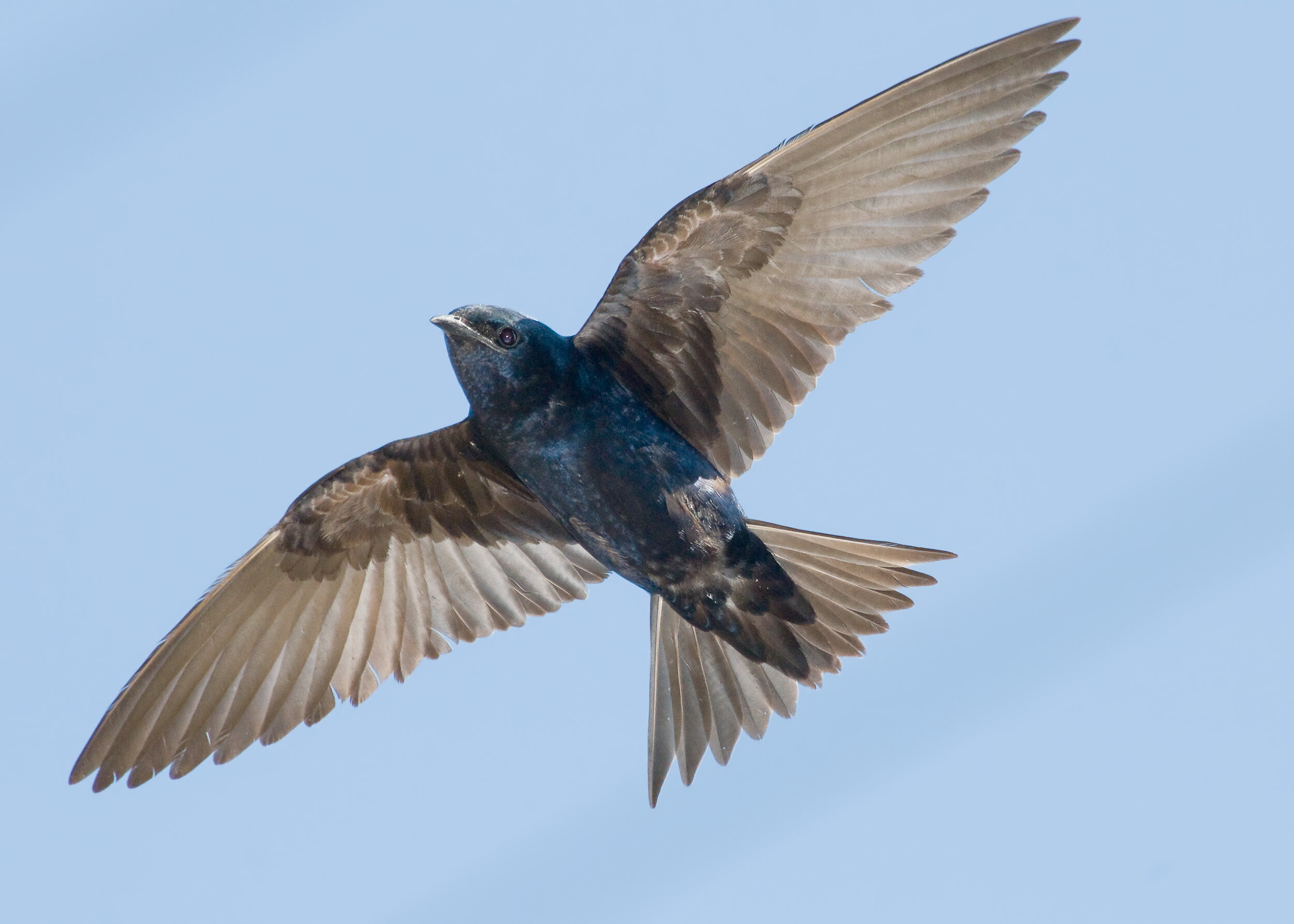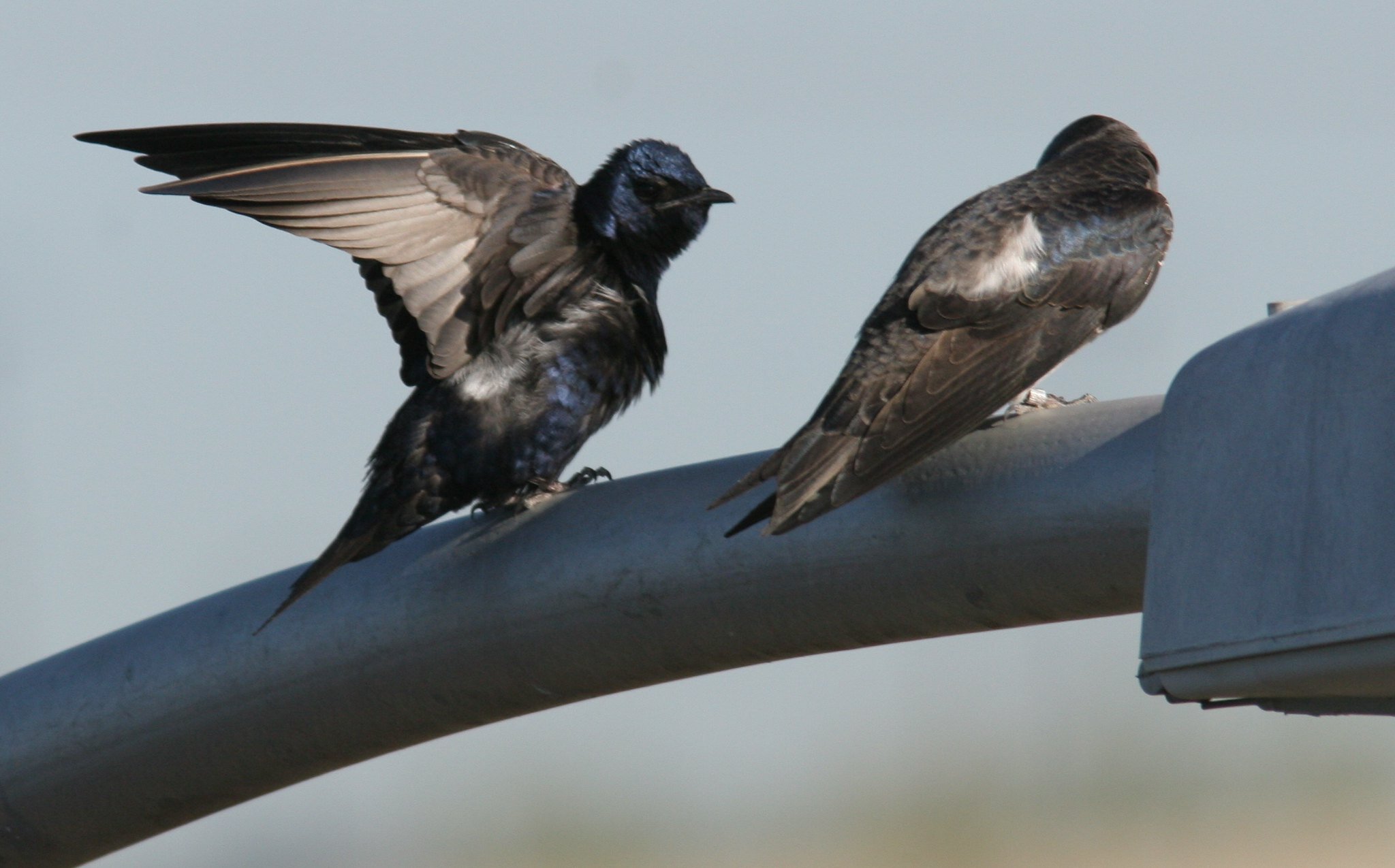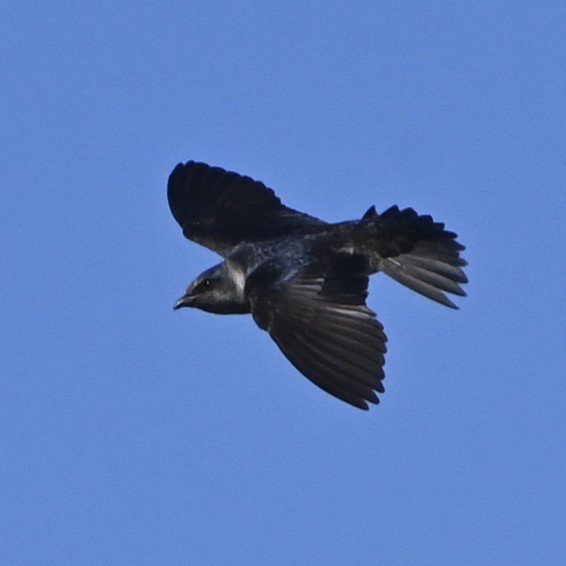Adult Male Purple Martin, Image by Daniel Lee Brown
This month, let’s talk about a fascinating bird called the Purple Martin (Progne subis). Purple Martins are the largest swallow found in North America. They are long-distance migrants, skilled and acrobatic flyers, and can reach speeds of up to 40 miles per hour. Along with other swallow species, Purple Martins share a flight pattern that is a combination of short glides and rapid flapping.
There are three subspecies of Purple Martin that can be found in the United States: an eastern subspecies (Progne subis subis), a western subspecies (Progne subis arboricola), and a subspecies found in certain desert regions of the southwest (Progne subis hesperia).
Sadly, the Purple Martin is a species of special concern across the United States. In California’s Central Valley, there has been a drastic decline. According to research by Dan Ariola, “the Sacramento population declined by 88% between 2004 and 2019.” What has caused their decline? Increased competition for nesting sites and the increased use of pesticides are two theories. The non-native European Starling and the House Sparrow have taken over the nest sites of many native species including those of Purple Martin. The invaders not only took over Purple Martin nest sites in dead trees, but also their nest sites in tile roofs of urban buildings. The increased use of pesticides is believed to have caused additional declines by decreasing the available food supply for Purple Martins. Researchers have found that specific pesticides developed in the 1990’s, called neonicotinoids, are extremely detrimental to Purple Martins. Neonicotinoids kill the flying insects that Purple Martin rely on for food.
What do Purple Martins look like?
Adult Male and Female/Immature Male Purple Martins, Image by Chris Conard
Purple Martins have notched tails, broad chests, slightly hooked bills, and long pointed wings that almost reach to the end of their tails. Adult Female and male Purple Martins are different in coloration. Males have stunning dark blue feathers on their backs, abdomens, and heads. They have brownish-black wings and tails. Females have dark blue backs, areas of blue and whitish-gray on their heads, gray necks, grayish-white chests and abdomens, and dark brownish-gray undertail feathers. Purple Martins have an iridescent sheen (luminous colors that appear to change when viewed from different angles) which can appear as navy blue, green, or dark purple. First year males have blotchy purple blue heads, necks, and sometimes chests. First year females are similar to adult females; but the colors are less pronounced. Juvenile birds do not get their full adult plumage for two years. They are a dull brownish-gray, have stubby tails, and have yellow color inside their beaks. Hatchlings (or newborns that recently emerged from eggs) are featherless, have eyes shut, are pink-skinned, and totally dependent on their parents.
Where do Purple Martins live?
Male Purple Martin, Image by Rich Howard
After spending winters in South America (in Brazil, Bolivia, Peru, or Ecuador), Purple Martins annually begin northerly journeys to their nesting sites in Mexico, the United States, or Canada. They usually return to their previous nesting locations year after year. Often, Purple Martins will nest in groups or colonies. However, sometimes nesting locations will only have a small number of birds. Occasionally, a single nesting pair will nest alone.
Historically, Purple Martin nested in old woodpecker holes inside dead trees or in holes in cliffs near wetlands, swamps, and waterfronts in natural riparian locations. However, use of man-made housing by Purple Martin’s began long-ago. Prior to European settlers coming to North America, a few Native Americans tribes routinely hollowed out and hung up gourds so that Purple Martins would nest in their villages.
While some Purple Martins still nest in dead tree snags in Oregon, populations in the eastern United States, Washington state, and British Columbia use human-made nest boxes (or multi-chambered structures for several pairs) almost exclusively. In the City of Sacramento, Purple Martins are unique. They nest in weep holes under freeway bridges.
Adult Purple Martins are feeding a nestling that hangs from the bottom of a weep hole underneath Highway 50 in Sacramento. Image by Rich Howard
Both parents typically share in both nest building and caring for their young. Pairs make nests out of twigs, mud, plant stems, and grass. They line their nests with fresh leaves for the eggs to lie on. Females incubate the eggs (sitting on eggs to keep them warm) for the majority of time. Males also help with incubation. The fledglings leave the nest 26 -32 days after hatching. Even after leaving the nest, the parents will continue to care for the young birds for around one month.
Frequently, in late summer after the young birds fledge (or leave the nests), both young and adult Purple Martins will gather in colonial roosts (places that groups of birds go to rest and sleep). They will continue to stay in flocks after returning to their wintering grounds.
If you’d liked to try to find Purple Martins in our area Sacramento Audubon recommends two locations. Please be aware that both locations are occasionally occupied by homeless encampments and use your best judgement when visiting these locations.
Purple Martins can generally be found in the following locations in and near downtown Sacramento:
Sutterville Rd overpass, east of Sacramento City College
Ramona Ave under Highway 50
Directions and more information can be found at www.sacramentoaudubon.org/city-of-sacramento/#sac-specialty.
What do Purple Martins eat?
Adult Male and Female/Immature Male Purple Martin, Image by Chris Conard
Purple Martins for the most part eat winged or aerial insects. They hunt for food over open habitat, often doing so in flocks or pairs. Because Purple Martins catch and eat flying insects when in flight, it saves a great deal of time when they are migrating to and from South America. Purple Martins eat flies, dragonflies, damselflies, butterflies, wasps, and bees, moths, beetles, fire ants, leafhoppers, cicadas, grasshoppers, crickets, and mayflies. Unseasonably harsh weather (cold temperatures or rain) lasting 3-4 days or more make it impossible for Purple Martins to find adequate food.
It has been reported that Purple Martins also eat spiders, However, only rarely do they come down to the ground to eat insects. They will come down to the ground occasionally to ingest a small amount of gritty matter or gravel which helps them digest the hard shells or exoskeletons that cover insects. Purple Martins drink water in flight by skimming the surface of lakes, ponds, and streams with their lower bills.
What do Purple Martins sound like?
Purple Martins are quite vocal and are frequently heard at dawn when they are flying. Their sounds are described as musical, chirps, buzzes, trills, rattles, gurgling, and whistles.
These songs and calls of the Purple Martin are from xeno-canto. More Purple Martin vocalizations can be found at xeno-canto.org/species/Progne-subis.
Works Referenced
Airola, Daniel A. Life Under the Fast Lane:The Ecology and Conservation of the Bridge-Nesting Purple Martins in Sacramento. Central Valley Bird Club, 2020.
Sacramento Audubon Society, “Sacramento Birds of Note,” https://www.sacramentoaudubon.org/birds-of-sacramento
Brown, C. R. and S. Tarof (2020). Purple Martin (Progne subis), version 1.0. In Birds of the World (A. F. Poole, Editor). Cornell Lab of Ornithology, Ithaca, NY, USA. https://doi.org/10.2173/bow.purmar.01
American Bird Conservancy, “Purple Martin” ABC’s Library, https://abcbirds.org/bird/purple-martin/
Toth, Molly “Migration Marvels Millenia in the Making” Bird Calls Blog, April 15, 2024, https://abcbirds.org/bird-migration-facts/
Cornell Lab of Ornithology, “Purple Martin” All About Birds, 2024 Cornell University, https://www.allaboutbirds.org/guide/Purple_Martin/
Washington Department of Fish & Wildlife, “Purple martin (Western North America subspecies) (Progne subis arboricola),” 2024 https://wdfw.wa.gov/species-habitats/species/progne-subis-arboricola#resources
National Audubon Society, “Purple Martin” Bird Guide, 2024 https://www.audubon.org/field-guide/bird/purple-martin





